Today’s Current Affairs: 26th April 2024 for UPSC IAS exams, State PSC exams, SSC CGL, State SSC, RRB, Railways, Banking Exam & IBPS, etc
Table of Contents
13th Ministerial Conference Of The World Trade Organization:
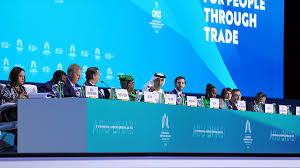
The 13th ministerial conference of the World Trade Organization (WTO), India asserted a robust position concerning the permanent solution for public stockholding for food security.
Key Points Highlighted by India:
- India has called for a shift in the WTO’s focus, urging it to move beyond catering solely to the trade interests of agricultural exporters.
- Instead, the organisation should prioritise addressing fundamental concerns such as food security and sustaining livelihoods.
- India argues that public stockholding programs are essential for developing countries to ensure food security for their populations, especially for vulnerable sections of society.
- The current WTO rules allow some leeway for developing countries regarding public stockholding programs.
- However, these provisions are temporary and India seeks a permanent solution that acknowledges their development needs.
- G-33 nations also upheld the right of the developing country to use the Special Safeguard Mechanism (SSM) as an important instrument against major import surges or sudden price declines.
- India stressed the necessity of creating a level playing field in international agriculture trade, especially for low-income or resource-poor farmers across the globe.
- This aligns with the broader goal of promoting fairness and equity in trade practices.
- India pointed out the glaring disparities in domestic support provided by countries to their farmers.
- Subsidies in some developed countries are reported to be up to 200 times higher than those in developing nations.
- Also, India as a member of G-33 nations also urged WTO to find a permanent solution to public stockholding.
Voyager 1 Spacecraft : Started Sending Readable Communications

NASA Voyager 1 spacecraft has begun sending readable communications again after months of transmitting gibberish back to Earth.
- NASA’s Voyager flight team detected a glitch in November and worked to fix the problem via code, leading to the successful return of readable data.
- Voyager 1 was launched by NASA on September 5, 1977.
- Voyager 1 is part of the Voyager program, which also includes Voyager 2.
- Objective is to study the outer Solar System and beyond, including flybys of Jupiter and Saturn.
- It discovered a thin ring around Jupiter and two new Jovian moons: Thebe and Metis.
- At Saturn, it found five new moons and a new ring called the G-ring.
- Voyager 1 was the first human-made object to cross the heliosphere and enter interstellar space in August 2012.
- It is the most distant human-made object from Earth and is expected to send data until at least 2025.
Satellite Technology Day 2024:

The U R Rao Satellite Centre (URSC) celebrated Satellite Technology Day (STD) – 2024, marking the 50th anniversary of the successful launch of India’s first satellite, Aryabhata, on April 19, 1975.
- Aryabhata was India’s first satellite, launched on April 19, 1975 from Kapustin Yar, a Soviet rocket launch and development site.
- The satellite was built by the Indian Space Research Organisation (ISRO) and launched by the Soviet Union as part of the Soviet Interkosmos program.
- It was named after the 5th-century Indian astronomer and mathematician Aryabhata.
- The satellite was instrumented to explore conditions in Earth’s ionosphere, measure neutrons and gamma rays from the Sun, and perform investigations in X-ray astronomy.
- It carried out three experiments, one each in X-ray astronomy, Solar Physics and Aeronomy.
1st ASEAN Future Forum:
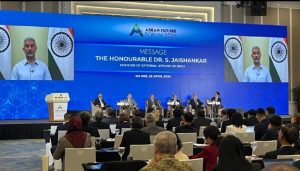
India’s External Affairs Minister, delivered remarks at the 1st ASEAN Future Forum.
- India supports ASEAN unity and centrality, emphasizing the importance of a strong and unified ASEAN in the Indo-Pacific region.
- ASEAN Future Forum was proposed by Vietnam at the 43rd ASEAN Summit in 2023.
- It is a common platform for ASEAN member states as well as partner countries to share new ideas and policy recommendations.
- It aims to contribute to promoting and shaping ASEAN’s development path.
Khanij Bidesh India Limited : MoU With CSIR – National Geophysical Research Institute

KABIL signed a MoU with the CSIR – National Geophysical Research Institute to foster a long-term collaboration in the field of critical and strategic minerals.
- Khanij Bidesh India Limited (KABIL) is a Joint Venture Company formed with the participation of National Aluminium Company Ltd. (NALCO), Hindustan Copper Ltd. (HCL) and Mineral Exploration Company Ltd. (MECL) in August, 2019.
- The equity participation between NALCO, HCL and MECL is in the ratio of 40:30:30.
- It is mandated to identify, acquire, develop, process and make commercial use of strategic minerals in overseas locations for supply in India.
- It is focusing on identifying and sourcing battery minerals like Lithium and Cobalt.
- It helps in building partnerships with other mineral rich countries like Australia and those in Africa and South America, where Indian expertise in exploration and mineral processing will be mutually beneficial bringing about new economic opportunities.
- The KABIL would carry out identification, acquisition, exploration, development, mining and processing of strategic minerals overseas for commercial use and meeting country’s requirement of these minerals.
Global Report On Food Crises (GRFC) 2024:
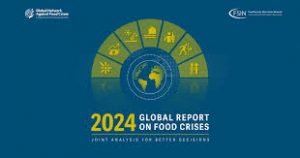
According to the recently released Global Report on Food Crisis (GRFC), nearly 282 million people faced high levels of acute food insecurity in 59 countries in 2023.
Highlights of GRFC 2024:
- It analyzed a population of 1.3 billion in 2023 across 59 countries. Nearly 282 million people faced high levels of acute food insecurity.
- 2023 was the fifth consecutive year of rise in the number of people suffering acute food insecurity, defined as when populations face food deprivation that threatens lives or livelihoods, regardless of the causes or length of time.
- It identifies conflicts, extreme weather events and economic shocks as the three main drivers behind the exacerbation of food crises in the world.
- With food crisis escalating alarmingly in conflict hotspots in 2023, notably Palestine (Gaza Strip) and Sudan, conflict / insecurity became the primary driver in 20 countries, directly affecting 135 million people.
- The Gaza Strip became the area with the most severe food crisis in the last eight years of GRFC reporting.
- Sudan is facing one of the worst food crises in the world, with almost a third of the population in need of emergency food aid.
- Meanwhile, weather extremes were the main driver for 18 countries, with over 72 million people facing high levels of acute food insecurity because of such extreme weather events.
- The 10 countries with the world’s largest food crisis in 2023 were the Democratic Republic of the Congo, Nigeria, Sudan, Afghanistan, Ethiopia, Yemen, the Syrian Arab Republic, Bangladesh, Pakistan and Myanmar.
- On a positive note, the situation improved in 17 countries in 2023, including the Democratic Republic of Congo and Ukraine.
Tiger Conservation Coalition:
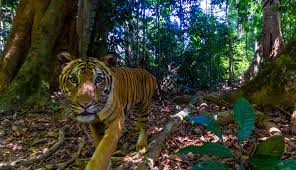
At the Sustainable Finance for Tiger Landscapes Conference, Bhutan and the Tiger Conservation Coalition Commit to Catalysing US$1 billion for tigers.
- Tiger Conservation Coalition is a group of NGOs that has worked for many years with partners to conserve tigers.
- Its vision is for a long-term presence of viable and ecologically functional populations of wild tigers secure in protected habitats, with representation and links across their indigenous range.
- It brings together leading tiger biologists and experts in wildlife crime, human-wildlife coexistence, policy, finance, development and communications with unprecedented alignment on achieving tiger conservation at scale.
- The eight non-governmental organisations (NGOs) includes the Environmental Investigation Agency (EIA), Fauna & Flora, the International Union for Conservation of Nature and Natural Resources (IUCN), Panthera, TRAFFIC, United Nations Development Programme (UNDP), Wildlife Conservation Society (WCS) and World Wide Fund for Nature (WWF).
- The members co-developed Tiger Conservation Landscapes 3.0, an integrated habitat modelling system to measure and monitor changes in tiger habitat at range-wide, national, biome and landscape scales in near real-time.
- This work serves as a model for objective, range-wide, habitat monitoring as countries work to achieve the goals laid out in the 30×30 agenda, the Sustainable Development Goals, and the Kunming-Montreal Global Biodiversity Framework.
National Panchayati Raj Day 2024:
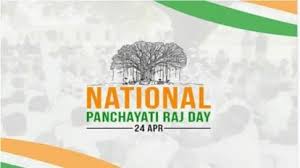
The National Colloquium on “Governance at the Grassroots after Three Decades of the 73rd Constitutional Amendment” was inaugurated in New Delhi to mark National Panchayati Raj Day 2024.
- The event will honour the best panchayats with awards for their efforts in improving the lives of rural households.
- The Ministry of Panchayati Raj in India observes 24th April as National Panchayati Raj Day each year.
- The 73rd Amendment Act of 1992 which gave constitutional status to Panchayati Raj Institutions (PRIs) and improved local self-governance in India was enacted on this day.
- India’s three-tiered (Gram Panchayat, Panchayat Samiti and Zila Parishad) administrative structure is known as the Panchayati Raj system, it aims to bring about improvement at the grassroots level in rural areas.
- It is important for achieving inclusive growth and addressing issues like climate change and rural-to-urban migration
Mpox Virus : Study
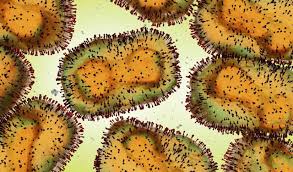
A study revealed a novel adaptation mechanism of the Mpox virus enhancing its ability to infect humans amidst recent outbreaks.
- The name was changed from “monkeypox” to “mpox” to avoid stigma towards monkeys and reflect the virus’s direct human infectivity.
- Mpox, also known as monkeypox, is a DNA virus.
- It belongs to the family Poxviridae, which consists of large, double-stranded DNA viruses.
- The virus was first identified in monkeys in 1958 but has since been found to infect humans as well.
- Mpox is primarily transmitted to humans from animals, particularly rodents and primates, through direct contact or through contaminated objects.
- Mpox infection in humans typically presents with fever, headache, muscle aches, and a characteristic rash that progresses from macules to papules to vesicles and pustules.
- While a vaccine for mpox exists, its availability and effectiveness are limited, highlighting the need for improved prevention and control measures.
- Mpox gained global attention during a widespread outbreak that affected over 100,000 people in more than 118 countries in 2022-2023.
- The outbreak was characterised by high human-to-human transmission, particularly through close contact and the sexual route.
- The World Health Organization (WHO) declared the mpox outbreak a public health emergency, leading to coordinated efforts to control its spread.
- Mpox genomes are divided into clades I and II, with evidence suggesting clade I has higher mortality.
- The 2022 outbreak involved a new lineage, clade IIb, better adapted for human-to-human transmission.
- Researchers found evidence of a distinct lineage of clade I associated with human-to-human transmission, suggesting a recent zoonotic spillover event.
- Mpox viruses can undergo genomic accordion through gene duplication or deletion to adapt to different hosts and environments.
Flood In Dubai:
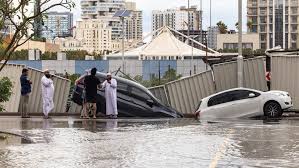
One of the heaviest rainfall was recorded in the United Arab Emirates (UAE), after a severe thunderstorm hit the country. The storm had initially hit Oman before it landed in the UAE.
- UAE lies in the arid regions of the world, so such heavy rainfalls are unusual there.
- On average, Dubai experiences 94.7 mm of rain in a year.
- But this event was historic as it brought more than 142 mm of rainfall that had soaked Dubai over 24 hours.
- The possible causes for such catastrophic event may be attributed to following reasons.
- Climate Change along with multiple factors associated with it like patterns of natural climate variability, such as El Niño and La Niña, has contributed to the extreme rain.
- It has led to higher temperatures causing evaporation of water not only from land but also oceans and other water bodies, causing a warmer atmosphere to hold more moisture.
- For every 1 degree Celsius rise in average temperature, the atmosphere can hold about 7% more moisture.
- This makes storms more dangerous as it leads to an increase in precipitation intensity, duration and/or frequency of storm.
- Cloud seeding is a process in which chemicals such as silver iodide crystals are implanted into clouds to increase rainfall in an environment where water scarcity is a concern.
- UAE, located in one of the hottest and driest regions on earth, has been leading the effort to seed clouds and increase precipitation.
- Thunderstorms are generated by atmospheric imbalance and turbulence caused by a combination of several conditions, including unstable, warm air rising rapidly into the atmosphere; sufficient moisture to form clouds and rain; and upward lift of air currents caused by colliding weather fronts (cold and warm), sea breezes, or mountains.




